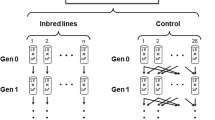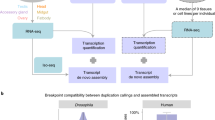Abstract
TWO genomic regions with unusally low recombination rates inDrosophila melanogaster have normal levels of divergence but greatly reduced nucleotide diversity1,2, apparently resulting from the fixation of advantageous mutations and the associated hitchhiking effect3,4. Here we show that for 20 gene regions from across the genome, the amount of nucleotide diversity in natural populations of D. melanogaster is positively correlated with the regional rate of recombination. This cannot be explained by variation in mutation rates and/or functional constraint, because we observe no correlation between recombination rates and DNA sequence divergence between D. melanogaster and its sibling species, D. simulans. We suggest that the correlation may result from genetic hitch-hiking associated with the fixation of advantageous mutants. Hitch-hiking thus seems to occur over a large fraction of the Drosophilagenome and may constitute a major constraint on levels of genetic variation in nature.
This is a preview of subscription content, access via your institution
Access options
Subscribe to this journal
Receive 51 print issues and online access
$199.00 per year
only $3.90 per issue
Buy this article
- Purchase on Springer Link
- Instant access to full article PDF
Prices may be subject to local taxes which are calculated during checkout
Similar content being viewed by others
References
Begun, D. J. & Aquadro, C. F. Genetics 129, 1147–1158 (1991).
Berry, A. J., Ajioka, J. W. & Kreitman, M. Genetics 129, 1111–1117 (1991).
Maynard Smith, J. & Haigh, J. Genet. Res. 23, 23–35 (1974).
Kaplan, N. L., Hudson, R. R. & Langley, C. H. Genetics 123, 887–899 (1989).
Nei, M. Molecular Evolutionary Genetics (Columbia Univ. Press, 1987).
Lindsley, D. L. & Sandler, L. Phil. Trans. R. Soc B. 277, 295–312 (1977).
Kimura, M. The Neutral Theory of Molecular Evolution (Cambridge Univ. Press, 1983).
Tajima, F. Genetics 125, 447–454 (1990).
Hudson, R. R. Theor. Populat. Biol. 23, 183–201 (1983).
Birky, C. W. Jr & Walsh, J. B. Proc. natn. Acad. Sci. U.S.A. 85, 6414–6418 (1988).
McDonald, J. H. & Kreitman, M. Nature 351, 652–654 (1991).
Aguadé, M., Miyashita, N. & Langley, C. H. Molec. Biol. Evol. 6, 123–130 (1988).
Miyashita, N. & Langley, C. H. Genetics 120, 199–212 (1988).
Schaeffer, S. W., Aquadro, C. F. & Langley, C. H. Molec. Biol. Evol. 5, 30–40 (1988).
Langley, C. H. in Population Biology of Genes and Molecules (eds Takahata, N. & Crow, J. F.) 75–91 (Baifukan, Japan).
Eanes, W. F., Ajioka, J. W., Hey, J. & Wesley, C. Molec. Biol. Evol. 6, 384–397 (1989).
Takano, T. S., Kusakabe, S. & Mukai, T. Genetics 129, 753–761 (1991).
Langley, C. H., Montgomery, E. & Quattlebaum, W. F. Proc. natn. Acad. Sci. U.S.A. 79, 5631–5635 (1982).
Aquadro, C. F., Deese, S. F., Bland, M. M., Langley, C. H. & Laurie-Ahlberg, C. C. Genetics 114, 1165–1190 (1986).
Langley, C. H. et al. Genetics 119, 619–629 (1988).
Game, A. Y. & Oakeshott, J. G. Genetics 126, 1021–1031 (1990).
Lange, B. W., Langley, C. H. & Stephan, W. Genetics 126, 921–932 (1990).
Leigh Brown, A. J. Proc. natn. Acad. Sci. U.S.A. 80, 5350–5354 (1983).
Leigh Brown, A. J. & Ish-Horowitz, D. Nature 290, 677–682 (1981).
Aquadro, C. F., Lado, K. M. & Noon, W. A. Genetics 119, 875–888 (1988).
Ashburner, M. Drosophila Genetic Maps (Drosophila Information Service 69, 1991).
Lindsley, D. L. & Grell, E. H. Genetic Variations of Drosophila melanogaster (Carnegie Institute, Washington DC, 1967).
Sousa, V. Chromosome Maps of Drosophila (CRC, Boca Raton, Florida, 1988).
Merriam, J., Ashburner, M., Hartl, D. L. & Kafatos, F. C. Science 254, 221–225 (1991).
Hochman, B. in Genetics and Biology of Drosophila Vol. 1b (eds Ashburner, M. & Novitski, E.) 903–928 (Academic, New York, 1976).
Author information
Authors and Affiliations
Rights and permissions
About this article
Cite this article
Begun, D., Aquadro, C. Levels of naturally occurring DNA polymorphism correlate with recombination rates in D. melanogaster. Nature 356, 519–520 (1992). https://doi.org/10.1038/356519a0
Received:
Accepted:
Issue Date:
DOI: https://doi.org/10.1038/356519a0
This article is cited by
-
Evolution of a plant sex chromosome driven by expanding pericentromeric recombination suppression
Scientific Reports (2024)
-
Pericentromeric recombination suppression and the ‘large X effect’ in plants
Scientific Reports (2023)
-
The effect of DNA polymorphisms and natural variation on crossover hotspot activity in Arabidopsis hybrids
Nature Communications (2023)
-
The roles of balancing selection and recombination in the evolution of rattlesnake venom
Nature Ecology & Evolution (2022)
-
The megabase-scale crossover landscape is largely independent of sequence divergence
Nature Communications (2022)
Comments
By submitting a comment you agree to abide by our Terms and Community Guidelines. If you find something abusive or that does not comply with our terms or guidelines please flag it as inappropriate.



